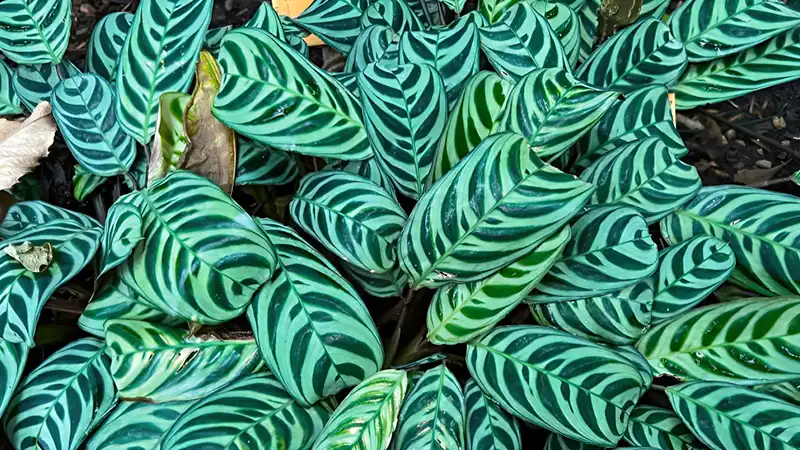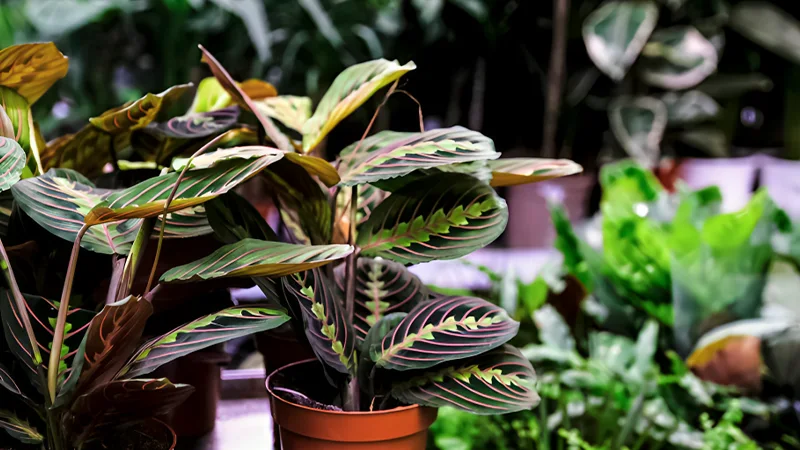Do you want to redecorate a corner of your house or office? If yes, you can consider adding some beautiful prayer-plants.
The Prayer Plant, or Maranta leuconeura, is a popular houseplant that can be planted indoors at any time of the year. It has beautiful patterned foliage with colors like pink, green, emerald, and lime.
Whether you are a beginner or a seasoned plant parent, you can easily grow this healthy indoor plant with the right tips. In this complete care guide, we will provide everything you need to know about keeping a prayer plant happy, including basic care tips, common concerns, and solutions.
About Prayer Plants

The prayer plant Maranta is a low evergreen plant that spreads with rhizomes, native to the tropics of North and South America. An interesting fact about the plant is that the leaves fold and turn upwards at night resembling folding hands in prayer, hence the name prayer plant. They put on a show for you every day, performing in your garden.
These plants have flat leaves, which emerge from the soil forming clusters. There are many types of pray plants, some of them have plain leaves, while many of them have vibrant colors and patterns. The brown blotches on leaves transform to emerald green and then to moss green as they age.
Although these plants rarely bloom in specific conditions, the flowers are white to pale purple with purple blotches and small spikes. Overall, they are one of the most unique tropical houseplants because of their decorative foliage. Additionally, they are also pet-safe as they are not toxic.
Let’s take a look at the table to get a clear and concise overview of the essential details.
| Common Name | Prayer Plant |
| Botanical Name | Maranta leuconeura |
| Type | Herbaceous perennial |
| Family | Marantaceae |
| Native Range | Brazil |
| Zone | 11 to 12 |
| Height | 0.50 to 1.00 feet (ca. 30 cm) |
| Spread | 0.50 to 1.00 feet (ca. 30 cm) |
| Bloom Time | Rarely flowers indoors |
| Bloom Description | White |
| Sun | Part shade |
| Water | Medium |
| Maintenance | Low |
| Suggested Use | Ground Cover, Naturalize |
| Flower | Showy |
| Leaf | Colorful, Evergreen |
People often confuse the Calathea prayer plants with the Maranta species. They are two different kinds of plants.
Popular Types of Prayer Plants
If you are sure about adding a prayer plant to your collection, the next thing you need to decide is the variety of the plant. There are a lot of different varieties, let’s take a look at some of the most common and popular varieties for houseplants.
Fishbone Prayer Plant (Ctenanthe burle-marxii)
It is one of the easiest prayer plant species to take care of. It has beautifully decorated foliage and typical purple leaf undersides. This can be a great entry point for these species, and it can also be added to a terrarium.

Pink Prayer Plant (Maranta leuconeura, Erythroneura)
This type has usually dark green leaves with some lime green color in the middle part. The most striking feature is the bold pink veins on the leaves. It is a stunning plant to add to your home.

Red/Tri-Colored Maranta (M. leuconeuravar. erythrophylla)
It is a tri-colored and variegated prayer plant, also known as the herringbone plant. It is one of the most popular types among the plant enthusiasts. Similar to Erythroneura, these plants also feature bold red veins, enhancing their beauty.

Black Maranta (M. leuconeura var. massangeana)
As the name suggests, this type has a darker leaf with silver blotches and white veins on the leaf. It is a stunning plant but it is not that common, so you might have to go an extra mile to get your hands on this type.

These are just a few of the major varieties of beautiful praying plants. Each of these types has a unique appearance that can light up any corner of your house. Moving on, let’s learn how to take care of all the varieties of praying plants.
Basics of Prayer Plant Maintenance and Care

These green and purple praying plants have a reputation for being challenging to grow, plus they are slow growers. They want everything to be perfect, otherwise they will give you a hard time. Neither too hot nor too cold. Neither too dry nor too wet. However, if you can find the sweet spot, they will flourish. Here are some of the key requirements of these plants.
Light
These pray plants mostly grow in a lower light setting in their native region. Thus, they will grow best in bright to medium and indirect sunlight. You should try to keep them in partial shade with the help of a shady window or sheer curtains. Also, you should be aware of drafts by windows.
Water
These plants like their soil to be moist at all times, and they can’t handle frequent periods of drought. You don’t need to water them every day, just try to water them whenever the top layer of soil gets dry. Usually, you will need to water them just once or twice a week. Additionally, try to give rainwater or distilled water, as they can be sensitive to hard water.
Soil
To facilitate better growth indoors, you would need well-draining, acidic, and loamy soil. This allows the soil to remain moist while also making airspace for the exchange of gases. A traditional potting mix can work well, but you can make a better one by mixing 2 parts of sphagnum peat moss, 1 part of loamy soil, and 1 part of coarse sand.
Temperature and Humidity
We know that these plants are tropical, thus they like warmer air. You do not have to provide hot conditions, but the optimal temperature is between 65-85 °F.
Now, if we talk about the humidity, these plants just love humidity. Often the heat and central air cooling systems lower the levels of humidity in your home. Thus, you should consider investing in a good humidifier around your praying plant area, especially if your home is dry. Alternatively, you can mist the surroundings of the plant. However, a humidifier will give you better results.
Fertilizers
These plants should be treated with fertilizers with water-soluble houseplant fertilizer every 2 weeks. You need to reduce this to once a month during the winter season. Again, they need just the right amount of fertilizer. Using too little amount will hamper your plant’s growth, and too much of it can lead to the burning of the plant’s roots.
So, these are the basic tips to nurture your prayer plants. In the following sections, we will explore some more nitty-gritty of growing and maintaining the plant.
Repotting and Pruning Prayer Plants
Repotting is one of the essential needs of any plant. Plus, it is a crucial part of your gardening journey. In the case of prayer plants, you should try to change the pot every 2 to 3 years. You may also need to change the pot if the roots come out of the drainage holes. You might have some idea from the above information that they are too sensitive, so please try to be gentle when repotting.
Another important aspect of gardening is pruning. Pruning is important to keep your plant healthy. Regularly pruning dead or yellow leaves will help you keep them healthy. Always cut it just above the leaf nodes using a clean pair of garden scissors. Pruning 2 to 3 times a year will help in getting a bushy growth.
Common Pests and Diseases
Prayer plants, like any other houseplant, face the risk of pests and diseases. But figuring this out in the initial stages and immediately taking the required actions can go a long way in keeping them healthy.
Root rot is one of the most common diseases among these plants. This disease occurs due to fungal attack, which mostly thrives in moist conditions. Overwatering and inefficient draining mechanisms are the major causes of root rot. Try to decrease the water and change the pot with fresh potting mix to overcome this issue.
Aphids, thrips, and spider mites are the most common pests to attack these plants. These pests have the power to multiply rapidly, thus it is important to catch and treat them as soon as possible. You should check your plants regularly to identify any problems early. If the infestation is severe, try to treat the plant with Neem oil or insecticidal soap.
Common Prayer Plant Problems and Solutions
As mentioned earlier, they need just the right conditions for growing. Thus, they are likely to encounter issues like browning, dropping, and yellowing of leaves. Let’s discuss these issues and their probable solutions.
- Prayer Plant Leaves Turning Yellow: This mostly happens due to improper watering and sunlight. Yellow color in leaves is an early warning sign for diseases like root rot.
Here, you should try to check that the plant is not sitting in soggy soil. Try not to overwater or underwater the plant, while ensuring that the humidity level is not too high and not too low.
- Prayer Plant Brown Tips: Browning on the tips of the leaves is a major problem that usually happens due to a lack of humidity, sunlight, or water. Sometimes browning of leaves can also occur after they turn yellow due to root rot.
In this case, make sure that the praying plant is sitting in an area that has enough humidity. You can mist the leaves or use a humidifier to achieve the desired results. You should also trim brown or damaged leaves to facilitate fresh growth.
- Drooping Leaves: Pest infestations, harsh changes in humidity or temperature, excessive chemicals, and underwatering are some of the major causes of dropping leaves in prayer-plants.
You should closely examine the plant and its surrounding environment. You should check for any recent changes and take the steps necessary to rectify that mistake.
Final Words
We have discussed all the important things to grow and maintain a prayer plant. Once you know every aspect of growing this plant, you will be confident and enjoy the process. These beautiful and elegant plants are waiting to enhance the space of your house. However, you need to be a little sensitive to keep them happy.
We hope this detailed guide will provide you with all the tools to successfully grow a healthy and vibrant plant. Please share this article with those who would benefit from it.
How fast do prayer plants grow?
These plants can grow to a maximum height of 12 inches and generally grow very slowly.
Which is the best place to put a prayer plant?
They grow best in warm, humid, and bright areas. Thus, the kitchen and bathroom can be ideal for these plants to grow. Most importantly, you should try to keep them away from air conditioners, heaters, and fans.
Why do prayer plants move at night?
In reaction to darkness, these plant displays a behavior known as Nyctinasty, in which the leaves fold upward. This phenomenon happens due to changes in light and temperature.
Do prayer plants bloom?
Although it is rare, they can bloom indoors in the spring and summer in near-perfect conditions. Prayer plant flowers indicate that the plant is healthy and is growing in the right conditions.
- Maranta leuconeura – Wikipedia
- Prayer Plant – Britannica



